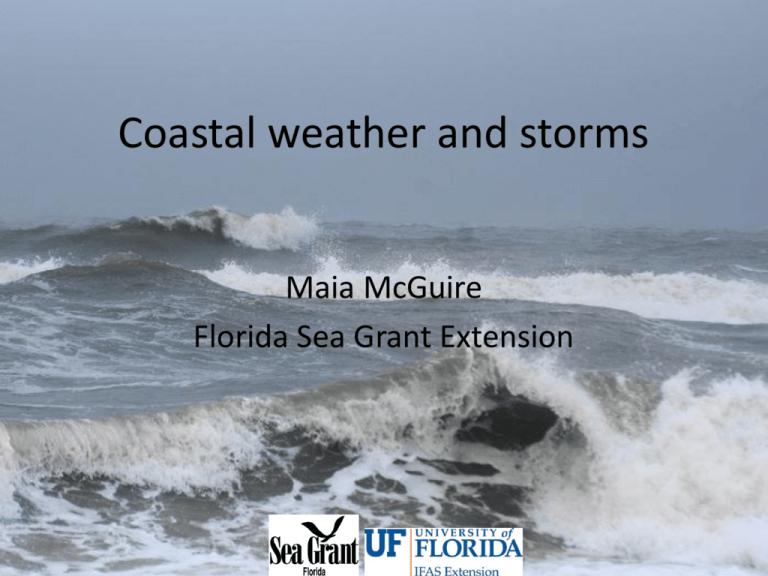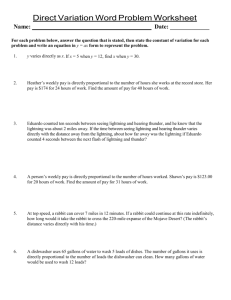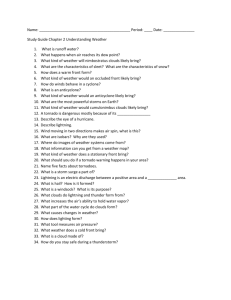Coastal weather and storms
advertisement

Coastal weather and storms Maia McGuire Florida Sea Grant Extension Weather • The state of the atmosphere at a given time and place, with respect to variables such as temperature, moisture, wind velocity and barometric pressure Activity • Scholastic’s “Weather Watchers” activities • www2.scholastic.com/browse/unitplan.jsp?id-256 Water cycle • http://www.eo.ucar.edu/kids/wwe/index.htm Clouds • A large collection of very tiny droplets of water or ice crystals • The droplets are so small and light that they can float in the air • Rising air contains water vapor, which condenses on tiny dust particles to form clouds http://eo.ucar.edu/webweather/cloud3.html Thunderstorms • • • • Storms with lightning (which makes thunder) Produced by cumulonimbus clouds Gusty winds, heavy rain and sometimes hail Usually happen in spring and summer months during afternoon and evening hours Lightning • A bright flash of electricity produced by a thunderstorm • Lightning kills and injures 75-100 people per year • Where is lightning right now? http://thunderstorm.vaisala.com/explorer.html Thunder • Sound wave created by moving air following a lightning bolt • Travels 1 mile in 5 seconds • If lightning is more than 15 miles away, we will not hear the thunder (it’s too far away). We can still see the lightning as light travels faster than sound Lightning safety • Outdoors – If you hear thunder, go to a safe place like a sturdy building or a car (roll up the windows) – Stay away from trees. If you cannot get to a safe place, crouch down in an open area—try to get twice as far away from a tree as it is tall – Groups of people should spread out (about 15 feet apart) – Stay out of water, avoid metal—even your backpack! Lightning safety • Indoors – Avoid water – Do not use a corded telephone – Do not use computers or appliances (electrical equipment) – Stay away from windows and doors, and off porches CALL 911 IF SOMEONE IS STRUCK BY LIGHTNING Winter storms • Form when two air masses (one cold and dry, one warm and wet) meet • Meeting point is called a front • Nor’easters form along the Atlantic coast of the US—warm air from the Gulf Stream is pushed into cold air from the land resulting in hurricane-force winds, high surf and lots of rain. Hurricanes • Very large storms • Can be up to 600 miles across • Strong winds spiral inward (counter-clockwise) and upward at speeds of 75-200 mph • Central portion (“eye”) is calm • Usually lasts about a week • Energy comes from warm ocean water (80°F) • Hurricanes usually form between 5 and 15° N or S of the equator • Wind movement needs to be fairly consistent (speed and direction) • Atmosphere must cool off quickly with altitude • Atlantic Hurricane season is June 1-Nov 30 Storm surge • Shallow-water coastline • Deep-water coastline Oceans and temperature • Water warms more slowly and cools more slowly than air. • Coastal areas can be warmer in winter (or cooler in summer) than inland areas because of this. Cool online resources • For KIDS: – www.weatherwizkids.com – http://eo.ucar.edu/webweather/ – http://www.eo.ucar.edu/kids/dangerwx/hurricane 1.htm – http://climate.nasa.gov/kids/index.cfm • For TEACHERS: – http://www.meted.ucar.edu/comm_k12.htm Climate • NOT THE SAME AS WEATHER • Long-term averaging of weather (over several decades) Oceans and climate • Oceans trap atmospheric heat







